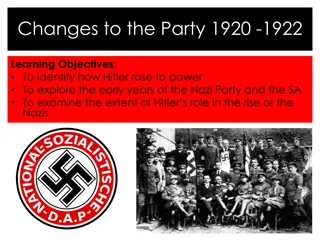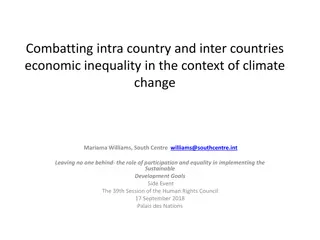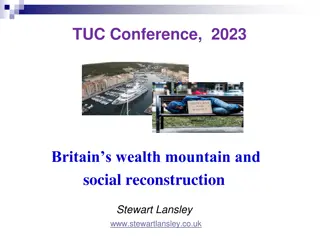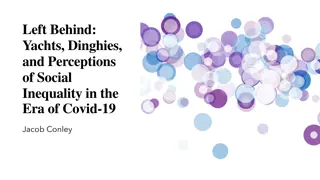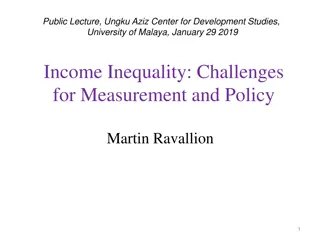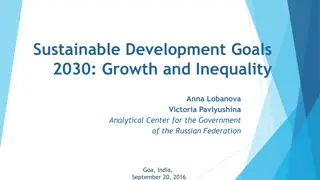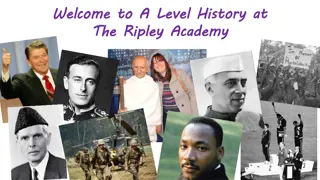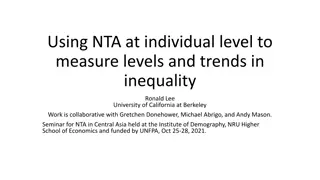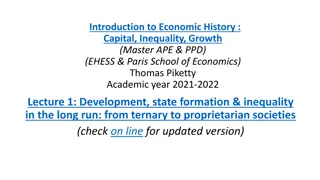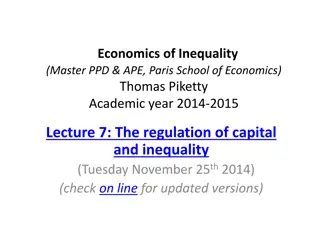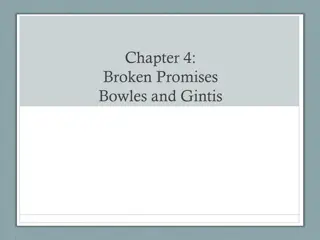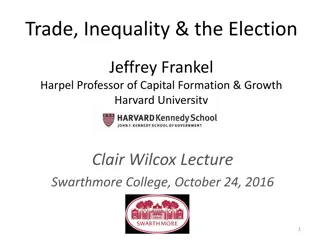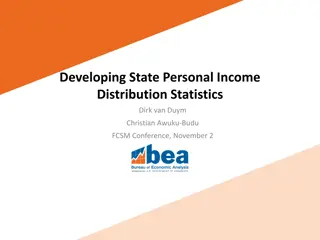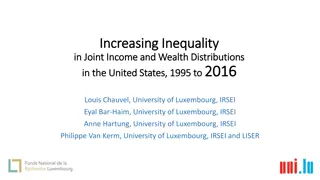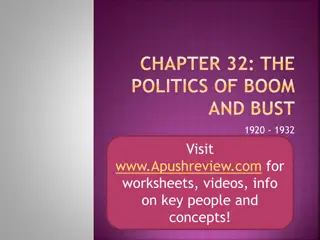The USA 1920-1973: Opportunity and Inequality Part One
In the booming 1920s USA, technological advancements, mass production, and Republican policies led to economic growth, with a significant focus on consumer goods like cars, radios, and refrigerators. While the era saw a rise in prosperity for some, including business owners and investors, others, such as farmers, workers in old industries, African-Americans, and new immigrants, faced challenges due to overproduction and technological shifts. Women's roles began evolving, with more joining the workforce and experiencing newfound freedoms.
Download Presentation

Please find below an Image/Link to download the presentation.
The content on the website is provided AS IS for your information and personal use only. It may not be sold, licensed, or shared on other websites without obtaining consent from the author.If you encounter any issues during the download, it is possible that the publisher has removed the file from their server.
You are allowed to download the files provided on this website for personal or commercial use, subject to the condition that they are used lawfully. All files are the property of their respective owners.
The content on the website is provided AS IS for your information and personal use only. It may not be sold, licensed, or shared on other websites without obtaining consent from the author.
E N D
Presentation Transcript
The USA 19201973: Opportunity and inequality Part One: American people and the boom Key issue & summary description Key facts In 1916, only 15% of American homes had electricity. By 1927 nearly 70% of homes had electricity. There was more building work done in the 1920s than at any other point in American history. In the 1920s the purchases of radio sets increased by 2,500%. What was the boom and why did it happen? During the 1920s more money was spent on things that people hoped would improve their lives, like cars, telephones, radios and refrigerators. People bought so many of these that businessescreated more jobs and paid workers more, so they could spend more on other products (the cycle of prosperity ). This was called a boom a period of very quick growth in the economy of the USA. Some reasons for the boom (economic growth): New technologies like electricity; new methods of advertising e.g. billboards, catalogues, radios; hire purchase; mass production; republican government policies. 15 million people bought Model Ts between 1911 and 1929. In 1927, one completed Model T came out of the factory every ten seconds. Road construction was the biggest single employer in the 1920s. How did mass production contribute to the boom? In 1913 Henry Ford created the first moving production line in the world. This meant cars were made more quickly, and cheaply, so the price of the model T went down, and more people bought them! Cars brought freedom to many Americans lives, e.g. they could live further from work and travel for leisure and holidays. Other industries were supportedby the car industry. e.g. Glass, leather, steel and rubber were all required to build new cars. Petrol was needed to run them. The richest 5% of people owned 33% of the wealth. Total farm income in the USA dropped from $22 billion in 1919 to $13 billion in 1928. 6 million Americans moved from the countryside to the cities. Three-quarters of a million black American farm-workers became unemployed in the 1920s. Unemploymentdid not reduce across the 1920s it remained steady at 5%. Inequalities of wealth Who benefited from the boom? The biggest winners were business owners and investors. Who didn t benefit from the boom? Farmers: Some farmers did make money, but most struggled. The main problem was overproduction. Prices were so low that many farmers could not afford to pay for their farm. Workers in old industries: Old industries such as coal mining, leather and textiles struggled because of new technologies and new industries (like oil and electricity). African-Americans: The majority of African-Americans lived in the Southern states, and worked in low-paid farming jobs as sharecroppers. New immigrants: The newest immigrant groups often struggled to access well paid jobs or housing. Republican government policies Presidents: WoodrowWilson, Warren G Harding, Calvin Coolidge, Herbert Hoover. Presidents in the 1920s were from the Republican party. Their policies included Rugged Individualism (the idea that people should look after themselves), Laissez faire, low taxes and tariffs. The stock market boom 5 times as many people owned shares in 1929 than 1920. Millions of people began to play the stock market in the 1920s. This meant buying and selling shares in companies. This was done through the stock market. This helped businesses to generate the money they needed to make more products.
Key issue & summary description Key facts Babe Ruth (baseball player) earned $80,000 per year. Jazz musicians: Louis Armstrong, Duke Ellington. Up to 100 million people per week went to the cinema. Why was it called the roaring 20s? Millions of Americans had more money and spent it on leisure. Sports: baseball, golf and boxing were supported by radios, newspapers and magazines. Jazz music became incredibly popular and generated new dances such as the Charleston. Cinema: Hollywood became the centre of the movie industry, with silent movies until 1927. New films showed the changing standards of society and horrified many older Americans. The Hays Code introduced strict new rules for films. How did women s lives change? 25% more women had jobs in 1929 than in 1920. Before the 1920s, most women were expected to be housewives, and would not take part in sport, wear make-up or smoke in public. In the 1920s, things began to change, especially in cities and towns. All American states gave women the vote in 1920. More women took jobs in factories and new industries. Younger and urban women (called flappers) began to wear more daring clothes (e.g. shorter skirts), they smoked and drank in public, and even kissed men in public. But: Women were still paid less than men, even when they did the same job. Most women in the countryside did not experience any of the changes in the cities, and still lived to support their family, without any of the new fashions. Around 3,000 prohibition agents, and 18,600 miles of coastline to patrol. By the 1930s, approx. 200,000 speakeasies in America. Al Capone made $10 million a year from racketeering. How did Prohibition and organised crime impact on society? Prohibition banned the sale, making or transportation of alcohol. It was in place from 1920-1933. The law was also known as the 18th Amendment or the Volstead Act. Groups like the Anti-Saloon League wanted alcohol to be banned as they saw it as immoral and a danger to society. Many Americans did not support prohibition and continued to drink most were never punished. Speakeasies, bootleggers and moonshine meant alcohol was easily available. Many criminal gangs made profit from controlling the sale of illegal alcohol. These gangs also got involved in other illegal activity, and as a result violence and crime were linked to Prohibition. Prohibition ended because of public pressure to end violence, create jobs and raise taxes from making alcohol legal again. By 1925, KKK membership was around 5 million. Nearly 2 million African Americans left the Southern states for the North. How did race and immigration cause tension? The vast majority of Americans were either immigrants or descendants of recent immigrants. The USA had always prided itself on being a melting pot , but this wasn t always the case. More established immigrant groups looked down on recent eastern European and Italian immigrants, and African Americans and Mexicans were almost at the bottom of the scale. Native Americans had very few rights and little access to land or money. Laws in the 1920s made it harder for non-WASPs to enter America. Many African Americans suffered from prejudice and discrimination. In Southern states, Jim Crow laws enforced segregation and the KKK saw membership rise. The KKK saw itself as defending white Protestant American values. What was the Red Scare? Over 6000 suspected Communists were arrested and imprisoned in the 1920s. Many Americans were scared of Communists, anarchists and anyone who might be either of these (such as new immigrants from southern and eastern Europe). Theywere seen as un-American for encouraging strikes and being too committed to workers rights rather than letting businesses be free. Sacco and Vanzetti were found guilty of murder and executed. However, they did not receive a fair trial as they were Italian anarchists. The trial received worldwide media attention.
The USA 19201973: Opportunity and inequality Part Two: Americas experiences of the Depression and the New Deal Key issue & summary description Key facts In 1929 alone, 659 banks went bankrupt. Shareholders lost a total of $8000 million in October. By 1933, 5000 banks had gone bankrupt. What was the depression? In October 1929, many investors panicked and sold their shares on the stock market. This caused the Wall Street Crash, where share prices in almost all companies dropped significantly. Individuals, businesses and banks lost money. People lost confidence, and started to keep their money at homes instead of banks. Many businesses were overproducing already, and the crash added to their problems. This caused unemployment to rise, and began a time called the Great Depression. By 1933 there were 14 million unemployed. Between 1929 and 1932, factory production dropped by 45% (people jus weren t buying things). By 1932, one in twenty farmers had been evicted. How did the Great Depression affect people s lives? Individuals: People did not have confidence to buy shares, so businesses did not have much money anymore. They cut jobs, causing unemployment and those with jobs were paid less. Homeless people filled parks at night, or built shanty-towns nicknamed Hoovervilles . Farmers had struggled in the 1920s with overproduction. The WSC meant that fewer people could afford to buy farmers products, so many farmers couldn t pay their mortgages. Many farmers moved to cities to look for work. Added to this, the dust bowl made large areas impossible to farm. Businessmen: factories struggled to sell goods in the USA due to the depression, and struggled to sell abroad due to tariffs. If they had loans from banks then they had to repay them. He cut taxes by $130 million in 1930. Made $300 million available to help the unemployed, but the states only gave out $30 million. What did Hoover do? President Hoover promised that things would get better over time, but he did not take much action to solve the depression. People blamed him for this. This is not entirely fair he did cut taxes, put tariffs on foreign goods, made money available for the unemployed and set up the RFC to help businesses. However people said Hoover had done too little, too late. When the bonus army demanded early payment of their war bonus from the President, Hoover set the army on them, who used violence and tear gas. Roosevelt won very easily - by 7 million votes. During the campaign, Roosevelt travelled 20,800km and often spoke on the radio. Why did Roosevelt win the 1932 election? Roosevelt s policies: He promised that the government would create jobs and sort the banks out. He called this a new deal. He had experience of helping unemployed people in New York. Roosevelt s personality: Roosevelt was a great speaker, and traveled widely around the country. He suffered from polio, and people associated with him as they felt he could work hard through America s problems. Hoover s policies: people blamed Hoover for the depression, and he appeared uncaring. Hoover s personality: Hoover wasn t a great public speaker, and his election train was once pelted with eggs.
Key issue & summary description Key facts The CCC gave 2.5 million young men jobs. The CWA gave temporary jobs to 4 million men, and built 150,000 public toilets. The HOLC helped 300,000 homeowners in its first year. What was the New Deal? Roosevelt took a range of actions intended to deal with the depression. Together, these are called The New Deal . In his first 100 days Roosevelt took significant action: The Emergency Banking Act brought confidence to businesses and individuals. Roosevelt ended Prohibition so the government could raise money from taxes on alcohol. He cut the pay of government workers so he could use this money for the unemployed. He then created a range of groups to help solve different problems these are called the Alphabet Agencies. For example: The CCC paid young men to work on environmental projects. The PWA created jobs building schools, roads, bridges and airports. The NRA improved working conditions in many jobs. Only 8,000 women were involved in the CCC. Unemployment: 1932: 12 million 1937: 8 million 1941: 5.5 million How effective was the New Deal? Millions of jobs were created, and banks were stabilised, but there was still mass unemployment. Around 200,000 black Americans benefitted from organisations like the CCC. But many New Deal agencies discriminated against black people they either got no work, or received lower wages. Some women were very important in making the New Deal successful. But most agencies were targeted at men. Native Americans were given some money to help them make better use of their land. But they were still a poor and excluded section of society. Huey Long promised every family $5000 to buy a car, a radio and a house. Dr Francis Townsend wanted everyone to retire at 60, to create jobs for younger people. Who opposed the New Deal? The New Deal isn t doing enough! Radical politicians like Huey Long argued that the rich should pay more tax, and nobody should earn more than $1million per year. This money would be used to help the poor. The New Deal is doing too much! People like the rich and the Republicans said that the New Deal was too complicated, the government was getting involved too much with people s lives, and businesses were paying too much tax. The Supreme Court ruled that parts of the New Deal were unconstitutional as it should be down to individual states to decide how to help groups like farmers. On average, 60 million people went to the cinema each week. Popular culture in the 1930s Jazz, radio and the cinema remained popular. Gramophones and vinyl records began to be used, and talkies took over the cinemas. Comic books became popular and many authors focused on poverty, racism and social problems. Through the WPA, Roosevelt gave many artists the opportunity to create a lasting American artistic culture. General Motors took on an extra 750,000 workers. A total of $50.1 billion worth of materials were shipped to the UK, USSR, China and France. The impact of the Second World War: America s economic recovery The USA gradually changed its policy from isolation, to eventually sending troops into WW2. This had a huge impact on the American economy, and ultimately ended the problems of the Great Depression. The Cash and Carry Plan, then the Lend-Lease agreement created jobs from selling weapons, ships and planes. The War Production Board forced companies to convert to war production. Many jobs were created, and American businesses made profit from supporting troops worldwide. 7 million extra women were in employment at the end of WW2. 1 million African-Americans fought in WW2. The social impact of World War Two Women: job opportunities were created in war production and supporting the armed forces. This had a lasting impact on the expectations of women s roles in the USA. African-Americans: some companies improved employment rates of African-Americans, but not all. Some jobs were available in the armed forces, and some of the segregation barriers in the armed forces were reduced during the war.
The USA 19201973: Opportunity and inequality Part Three: Post-War America Key issue & summary description Key facts By the end of the 1950s, 9/10 households had a TV, 8/10 had a car and telephone, 7/10 had a washing machine. Average women s wages were 53% of men s. What was life like in the 1950s? The American dream developed in the 1950s as many Americans experienced growing prosperity, and came to expect a house in the suburbs and leisure time in shopping malls. President Truman tried to support this by creating a fair deal - raising the minimum wage and helping African- Americans. He wasn t completely successful and many Americans still lived in poverty with poor healthcare. Women s experiences were mixed, as many were not able to be as independent as they had been during WW2. 324 Hollywood personalities were blacklisted. The FBI kept files on around 1 million suspects. What was McCarthyism? After World War Two, the Red Scare led to thousands of people being accused of being Communists. This panic was fueled by the House Committee of Un-American Activities (HUAC) and Truman s Loyalty Programme which focused on the government, education and film industry. Senator Joseph McCarthy then led further investigations which won him support at first, but was then labelled a witch hunt . In 1957 teenagers were spending an average of $10-$15 a week compared to the $1-$2 in the early 1940s. 82% of Americans watched a single TV performance by Elvis in 1956. How did popular culture develop in the 1950s? With the booming economy, parents who had lived through the Depression wanted to help their children achieve more. Education pass rates improved and the teenager began to be seen as an independent group. Rock n Roll music and the increase in televisions created new cultures for families and for teenagers. In one year, MLK travelled 780,000 miles and made 208 speeches campaigning for civil rights. The Black Panthers had 5000 members by 1968. 1965-67 race riots in most of America s major cities. The Civil Rights Movement The Civil Rights Movement was a campaign in the 1940s, 50s and 60s for African-Americans to have equal rights to white Americans. Key figures: Martin Luther King: seen as a figurehead for his inspirational speeches and his non-violent approach. Set up the MIA and SCLC, awarded the Nobel Peace Prize in 1964. Presidents Kennedy and Johnson: Kennedy met MLK and began working on a Civil Rights Act, but struggled to get enough support. Johnson used the emotions from Kennedy s assassination to get it passed. Black Power: a range of people and groups who felt change was not coming fast enough. They supported a more militant approach (e.g. Black Panthers) and/or separatism (keeping the races apart, e.g. Nation of Islam, Malcolm X).
Key issue & summary description Key facts Over 70,000 people took part in sit-ins during 1960-1961, and over 3,000 were arrested. The March on Washington was attended by over 200,000 people. Within 3 years of the Voting Rights Act, almost all black Americans in the south had registered to vote. Main events in the Civil Rights Movement 1954: Brown v Topeka the Supreme Court rules that segregation in schools is unconstitutional. 1955-56: Montgomery Bus Boycott. Supreme Court rules that segregated buses are illegal. 1957: Little Rock High School Eisenhower uses federal troops to enforce the law. 1960-61: Sit-ins and freedom rides demonstrate how unfair life is in some areas. 1963: Freedom marches, including the March on Washington. 1964: Civil Rights Act outlaws segregation in many public places. 1965: Race riots begin. MLK s Selma march. Voting Rights Act. 1968: MLK assassinated. Civil Rights Act outlaws selling of houses based on race. In total, the minimum wage increased from $1 per hour to $1.40. African-American families in poverty reduced from 56% in 1959 to 30% in 1970. For white Americans this reduced from 18% to 8%. Did JFK and LBJ create a great society ? Kennedy spoke of taking America to a new frontier . After he died, Johnson promised to continue this and create a great society . They achieved many successes in civil rights, education, healthcare and poverty. However this did cost the government money and unemployment rates were not significantly reduced. JFK increased the minimum wage, cut taxes and improved social security for the elderly and unemployed. LBJ reduced African-American poverty, created Medicare (JFK s idea) and improved funding for schools. The 1963 Status Commission report found that women earned around 60% less than men for the same job, and only 4% of lawyers and 7% of doctors were men. In some jobs women could be legally dismissed if they married. In 1985, only 24 out of 535 politicians in Congress were women. What was the feminist movement? A report commissioned by JFK in 1960 found shocking statistics about the status of women in the workplace. This gained attention, and people were inspired by the Civil Rights Movement to campaign for equal opportunities for women, known as feminism. The National Organisation for Women (NOW) organized mass demonstrations and took companies to court over equal pay. Younger, more radical women used more extreme methods, known as women s lib .Despite changes to the law, women s average pay remained below that of men and widespread sex discrimination was still common. The Roe v Wade case led to a Supreme Court ruling that women had a right to safe and legal abortion.




